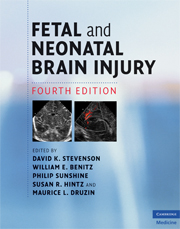Book contents
- Frontmatter
- Contents
- List of contributors
- Foreword
- Preface
- Section 1 Epidemiology, pathophysiology, and pathogenesis of fetal and neonatal brain injury
- Section 2 Pregnancy, labor, and delivery complications causing brain injury
- Section 3 Diagnosis of the infant with brain injury
- Section 4 Specific conditions associated with fetal and neonatal brain injury
- Section 5 Management of the depressed or neurologically dysfunctional neonate
- Section 6 Assessing outcome of the brain-injured infant
- 45 Early childhood neurodevelopmental outcome of preterm infants
- 46 Cerebral palsy: advances in definition, classification, management, and outcome
- 47 Long-term impact of neonatal events on speech, language development, and academic achievement
- 48 Neurocognitive outcomes of term infants with perinatal asphyxia
- 49 Appropriateness of intensive care application
- 50 Medicolegal issues in perinatal brain injury
- Index
- Plate section
- References
48 - Neurocognitive outcomes of term infants with perinatal asphyxia
from Section 6 - Assessing outcome of the brain-injured infant
Published online by Cambridge University Press: 12 January 2010
- Frontmatter
- Contents
- List of contributors
- Foreword
- Preface
- Section 1 Epidemiology, pathophysiology, and pathogenesis of fetal and neonatal brain injury
- Section 2 Pregnancy, labor, and delivery complications causing brain injury
- Section 3 Diagnosis of the infant with brain injury
- Section 4 Specific conditions associated with fetal and neonatal brain injury
- Section 5 Management of the depressed or neurologically dysfunctional neonate
- Section 6 Assessing outcome of the brain-injured infant
- 45 Early childhood neurodevelopmental outcome of preterm infants
- 46 Cerebral palsy: advances in definition, classification, management, and outcome
- 47 Long-term impact of neonatal events on speech, language development, and academic achievement
- 48 Neurocognitive outcomes of term infants with perinatal asphyxia
- 49 Appropriateness of intensive care application
- 50 Medicolegal issues in perinatal brain injury
- Index
- Plate section
- References
Summary
Introduction
Neonatal brain injuries represent a group of common yet heterogeneous disorders, which result in long-term neurodevelopmental deficits. A significant proportion is related to hypoxic–ischemic brain injury, either diffuse or focal (e.g., stroke). Neonatal brain injury is recognized clinically by a characteristic encephalopathy that evolves over days in the newborn period. This clinical syndrome includes a lack of alertness, poor tone, abnormal reflex function, poor feeding, compromised respiratory status, and seizures. Neonatal encephalopathy occurs in 1–6/1000 live term births, and is a major cause of neurodevelopmental disability. Up to 20% of affected infants die during the newborn period, and another 25% sustain permanent deficits of motor and also cognitive function. Functional motor deficits are often described as cerebral palsy, a non-progressive disorder of motor function or posture originating in early life. Cognitive deficits include mental retardation or learning disabilities, and impaired executive functions, language skills, or social ability. Other forms of neonatal brain injury, particularly in the term newborn, such as stroke, have an incidence as high as 1/4000 live births. More than 95% of infants with neonatal stroke survive to adulthood, and many have some form of motor or cognitive disability.
Thus, neurocognitive deficits that follow neonatal encephalopathy are serious problems that frequently result in lifelong disability with serious impact for the child, family, and society. In addition, even if neurocognitive deficits are mild, they affect academic achievement and quality of life.
- Type
- Chapter
- Information
- Fetal and Neonatal Brain Injury , pp. 575 - 584Publisher: Cambridge University PressPrint publication year: 2009

